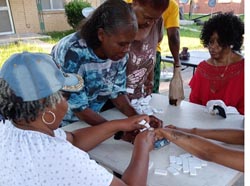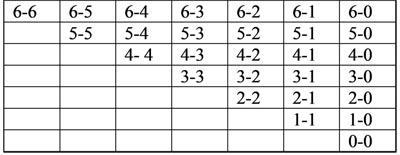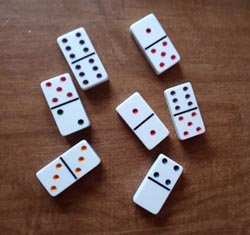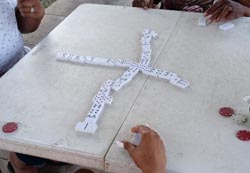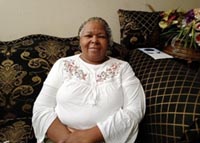Playing Dominos in Sabine Parish, Louisiana
By Rolonda Teal
Introduction
On Saturday, June 13, 2020, a few Zwolle, LA residents participated in a Domino Tournament in which a cash prize of $50.00 was available for the winners. This was the first year for the tournament, so the crowd was smaller than anticipated. The tournament began with six teams, however only five played due to a forfeit. Grandmother Mary Belton and granddaughter Dishika Lloyd played against good friends Bridgette Lynch and Ernie Mae McElroy. Two men, Billy Barkin and Jerry Williams, both favored to win the tournament, teamed up against two women, Veronica Lloyd and Catherine Kimbrough. Lastly, team Tammy Lloyd and Terry Williams played against the winners of Round 2. At the end of an hour or so, winners were declared, but before they are revealed, let us discuss the game of dominos.
History of Dominos/Dominoes
The oldest known form of the game originated in China during the Yuan Dynasty. A man named Zhou Mi wrote about it in his text, Former Events in Wulin, between 1232 and 1298. Zhou Mi referred to dominos as an item sold by peddlers between in the mid to late 1100s. While China is widely accepted as the originator of the game, some people have argued domino playing originated in Egyptian or Arabian cultures. The oldest known set of dominos were uncovered in King Tutankhamen's tomb in Thebes around 1355 BC. Ohers have argued dominos developed into its modern form in the Dominican Republic where the black dots on the white domino supposedly reminded people of masquerade ball masks. Another theory suggests the game got its name from the French word "Domino," which refers to the black robes and white hoods that were used by French and Italian priests during the winter and at some carnival celebrations.
If we accept the Chinese as the originators of the game; it is believed Italian missionaries brought dominos to Europe. When the game arrived in Europe in the 18th century, it was played first in Venice and Naples, Italy before diffusing to other parts of Europe such as England. In the European version of the game the sets changed to contain seven additional dominoes to represent the addition of a blank (0) and a number as well as a 0-0 combination. In the Chinese version, no blanks were on the face of the dominos..
While the originators of the game continue to be debated by people all over the world, it is likely we may never know who invented dominos. It is also highly conceivable independent invention rather than diffusion is why the game has become popular in cultures globally. With independent invention, cultural groups come up with the same ideas at different times and without knowledge of its previous existence.
Description of Dominos
Dominos are flat, rectangular blocks made of materials such as wood, plastic, or bone. Animal bones were a popular material used which is why, some believe, the reference to "bones" is often used when playing the game. Dominoes have circular dots on one side while the other side is left blank. The dotted side of each piece is divided by a line into two equal squares. The typical Western set contains 28 pieces, that are marked as follows:
In the past, some domino sets were black with white dots, now the more popular ones in this region are white with black spots and some dominos come in colors like red and green. Within the past 20 years dominos have evolved to feature sets with colored dots, which according to Veronica, "makes it easy to learn" the game. Since they are colored, a new player, or one with poor vision, doesn't have to focus on the spots but can simply look at the colors and match the ends.
Rules of the Game in Zwolle
"I learned how to play the game through my grandma and grandpa when I was about eight or nine". Veronica Lloyd's story is like many other's experiences who learned the game from an older relative. Veronica (Vee) stated her family often played the game at a table setup in the living room just for that occasion and removed the table once the game ended. Vee's grandparents played often on the weekends but also at any social gathering such as a bar-b-que, birthday, or holiday. She continued playing and learning at those events.
Although there are many ways to play the game, a basic form of the game, is sometimes called "straight dominos," and that was the version played at the Zwolle Tournament. The following is an overview of straight dominos. Each player chooses seven dominoes from a shuffled pile. After the bone is picked, it cannot be put back into the pile. Dominoes are placed in front of the player so only they can see them. To begin the round, the person who drew the highest double bone (6-6, 5-5, 4-4, etc.) plays first. Going clockwise around the table, players continue laying down bones. Each domino played must have a side that matches the open end of any previously played piece. Continue playing until one person no longer has any tiles left.
Photo: Rolonda Teal.
If a player cannot play a tile, then they must draw from the boneyard/gutter/stash. If the new bone matches something already on the table, then it can be played. If not, the player must add it to their hand and continue drawing from the boneyard/gutter/stash1 until they find a matching play or there are no more bones. When playing as a team (four players) there is no boneyard because all the dominos are in use.
The round is over/won when a player no longer has any bones left in their hand. This typically takes a minimum of seven turns. Following the round, each player must tally their score by adding up the total number of dots on the tiles that are left in their hand, or not played. On a sheet of paper or by using chips, add those numbers to the winner's score. Continue the game with a second round played the same way as the first. The game continues until someone reaches one hundred and fifty points, thus winning.
Scoring During the Game
Since the tournament was played in teams, the winners of the hand received as many points as there were dots on the dominos still held by their opponents. Hands or rounds continued to be played until one team reached the winning game score of 150 points. Points were calculated by multiples of five. On each turn, the objective is to play so that all the ends when added total multiples of five. Traditionally, points were written on a sheet of paper in which lines represented 5 points and circles represented 10 points. However, in this and other regions, the score is kept by using poker chips. The point value of chips in the Zwolle area is as follows: White=5, Red=10, Blue=50, Black=150. Just 30 miles up the road in Mansfield, Louisiana, for some players, the chip value changes, yet they are still used to mark the score.
Scoring Language
One of the elements of domino scoring is the colorful language used when counting points. Instead of calling out 5, 10, 15, when adding points, players will ask for their points in a "domino language." For example, Veronica provided a list of terms she uses when counting score. For her, a count of five might be "fire my pistol," a ten count is "Tennessee Titans," a 15 count is "threes please," a 20 count is "got a boatload" or "bolt the doors," a 25 count is "a quarter pounder," and a 30 count is "dirty thirty." For Bridgette, 15 points and up is when she might add more colorful language to the count. Instead of calling 15, she might simply say "young girls." A 20 count for Bridgette is "double trouble," and at 25 points is when she starts slapping bones.2
Another component of scoring is how the dominos are placed on the table. Known as slapping, the idea is to, as spoken by Bridgette, "make a point." For example, "if you get 25 dots, hey that's fabulous, so you gone hit it. Cause you gone have just one bone and you hit it; you just pop it down there." Bridgette prefers the ceramic dominos rather than the wood ones because the ceramic bones slap harder. In other words, ceramic tiles make a louder sound when slammed on a wooden table.
The Zwolle Tournament
Typically, tournaments are based on a 'rise and fly' principle in which the loser of the round is automatically eliminated from play. There was a total of four rounds in the tournament. Since there were only five teams the elimination process was slightly altered but was basically conducted in this manner.
The winner of each round advanced to the next round. By Round 4, and with no one else to play, the winners were declared, Earnie Mae and Bridgette. Of the teams that played, this combination was the least favorite to win which made the victory more rewarding. For compensation for their efforts the best friends split the grand prize of $50.00.
Domino's Popularity Today
Today, dominos are played all over the world. It is particularly popular in Latin America and Caribbean regions where dominos are considered a national pastime. The game of dominoes has evolved into more than fifty variants where rules change based on each country and region. While its popularity has led to the creation of domino clubs in some regions, that has not been the case in Sabine Parish. In fact, among young people, 30 years or less, the game is waning in popularity. The reason for the decline is only speculative but according to Bridgette, technology is stopping kids from playing. "The games that we played; they don't want to play no more. . . , they don't even play Spades."3 Veronica also observed a lack of interest in dominos and cards by her two sons, La Davion and Lee Arthur. According to Veronica, she doesn't see them wanting to learn the game anytime soon if ever. But, for her, domino playing was a custom that represented a time for socializing with extended family. Every weekend or every other weekend Veronica along with grandparents, aunt, cousins, and siblings, "would go to my Aunt Essie house and play dominos or she would come down here to my mama's [house]. It was always something to do and dominos was going to be played regardless, no cards, no nothing. It's just straight dominos."
Well, it never was actually "straight" dominos because an essential part of a domino game is the background entertainment which generally consist of music, dancing, and drinking. When Veronica was young, rhythm & blues provided the entertainment; however, nowadays it is primarily Southern Soul music playing in the background while dancing takes place either during or between rounds of play. The background music, like the game rules, change based on the people playing and their musical preferences.
Since this domino tournament concluded, Mary Lloyd-Belton passed in July 2020. Nearly, everyone in the community knew Mary for her domino and dancing skills. Members of the Lloyd family have expressed an interest in hosting an annual Juneteenth Domino Tournament in her honor. So, if any of the readers of this article happen to be in Sabine Parish around mid-June, look for an announcement for the tournament and enter. Who knows, you and your partner may be crowned the winners.
Notes
1. Boneyard appears to be a term used by older generations although sometimes used by younger players as well. The gutter was a term used by Bridgette Lynch who is in her 50s; while the term stash was used by Veronica Lloyd who is in her 30s.
2. The language used while counting can become vulgar at times depending on who is playing and the audience around.
3. Spades is a card game played with two to four players. It was played in many African American households during the 20th century
Sources
"Domino History." domino-play. Stormdark I.P. and Media 2017, www.domino-play.com/History.htm. Accessed 21 Dec. 2020.
Gamesaver Team. "The History of Dominoes (The Game)." www.gamesver.com/the-history-of-dominoes-the-game/. Accessed 28 Dec. 2020.
Horace, Hydes. "Dominoes." U.S. Patent No. 1,362,318. 14 Dec. 1920.
Lloyd, Veronica. 2020. Interview by author. Zwolle, Louisiana. June 13.
McElroy, Earnie Mae and Bridgette Lynch. 2020 Interview by author. Zwolle, Louisiana. June 13.
Rapport, Nigel. "The 'bones' of friendship: Playing dominoes with Arthur of an evening in the Eagle Pub." The Anthropology of Friendship. Oxford: Berg (1999): 99-117.
"The History of Dominoes." Domino-Games.com. 2020 www.domino-games.com/domino-history.html. Accessed 14 Dec. 2020.
The Editors of Encyclopedia Britannica. "Domino". Encyclopedia Britannica. www.britannica.com > topic > domino-game-piece. 27 Feb. 2019. Accessed 21 Dec. 2020.
Wilkinson, William H. "Chinese origin of playing cards." American Anthropologist 8.1 (1895): 61-78.


